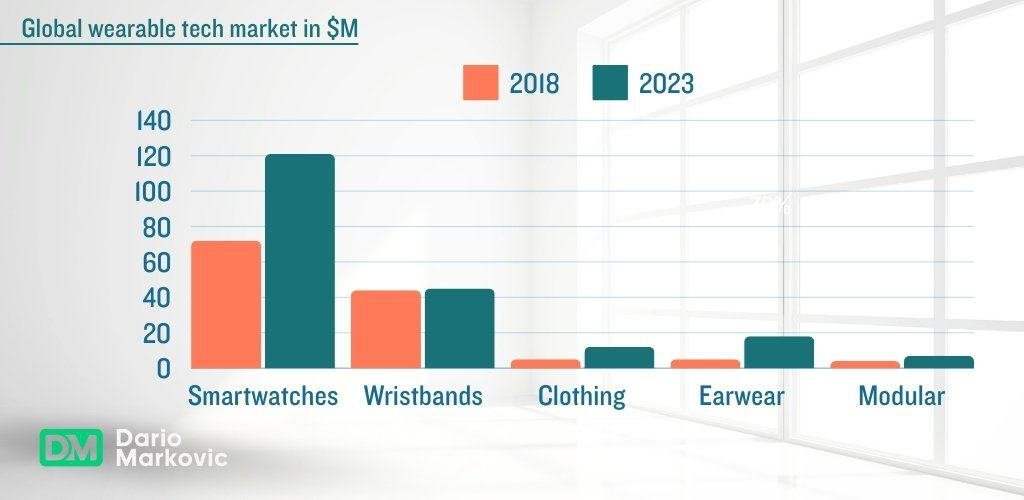Wearable Fitness Tech: The Fitness Revolution
Launching a successful dropshipping store on Shopify requires strategic product selection. Wearable fitness tech is one of the best niches to make a lot of money, fast. Let’s kick things off by introducing our keyphrase: wearable fitness tech.
These products not only align with consumer interests but also boast impressive monthly search volumes. So, what’s hot in the fitness tech arena?
What We’ll Discuss Here
Smartwatches and Their Fitness Magic: We’ll explore how smartwatches have become more than just timekeepers—they’re your personal trainers, tracking steps and heart rates while keeping you stylish.
Activity Trackers: Your Silent Fitness BFFs: These unassuming devices count steps, monitor sleep, and gently remind you to move. They’re like the friends who cheer you on during that extra lap.
Wearable Fitness Stats: By the Numbers: We’ll dive into impressive statistics—global shipments, revenue growth, and the rising popularity of fitness trackers. Data-driven decisions, anyone?
Sweat It Out with Smartwatches
Smartwatches are the MVPs of wearable fitness tech. They’re not just timekeepers; they’re personal trainers on your wrist. From step tracking to heart rate monitoring, these sleek gadgets keep you accountable. Brands like Whoop have revolutionized the game, offering a comprehensive look at your body’s key performance data. Plus, they’re as stylish as your favorite workout leggings.
Activity Trackers: Your Fitness Sidekick
Activity trackers—those trusty companions that count your steps, monitor your sleep, and nudge you when you’ve been sitting too long. Imagine them as your fitness BFFs, cheering you on during that extra lap around the park. These little wonders accounted for a whopping 58.73% of wearable fitness device shipments.
Heart Rate Monitors: Listen to Your Heart
Your heart knows best, and heart rate monitors help you listen. Whether you’re crushing a HIIT session or practicing yoga, these devices keep tabs on your ticker. Fun fact: Roughly 20% of American consumers regularly use a fitness tracker. So, let’s get that heart rate up—just not from stress while reading this blog.
Yoga Mats and Sports Bras: Fitness Essentials
Okay, they’re not exactly tech gadgets, but hear me out. Yoga mats and sports bras are essential for any fitness journey. Without a good mat, your downward dog might turn into an awkward squirrel pose. And a supportive sports bra? Non-negotiable. These products are the unsung heroes of the fitness world, quietly doing their job while you break a sweat.
Wearable Fitness Tech: By the Numbers

1. Market Size and Revenue
- In 2020, over 445 million wearable fitness devices were shipped globally. That’s more wearables than there are stars in the Milky Way (okay, maybe not, but it’s still impressive).
- Fitness tracker revenue grew by a whopping 31% during the pandemic. People were clearly investing in their health while binge-watching Netflix.
- The global fitness tracker market size was valued at USD 53.94 billion in 2023 and is projected to reach USD 290.85 billion by 2032, exhibiting a CAGR of 21.3% during the forecast period. That’s some serious growth—like a sprinter chasing a personal best.
2. Key Players
- Apple Inc.: The tech giant flexes its muscles with the Apple Watch series. It’s not just a smartwatch; it’s a lifestyle statement.
- Fossil Group Inc.: Their blend of fashion and function keeps wrists stylish and steps counted.
- Garmin Ltd.: Known for rugged smartwatches that survive mud runs and marathons alike.
- Samsung Electronics: Their Galaxy Fit series competes fiercely in the fitness tracker arena.
- Google LLC (Alphabet Inc.): Android Wear OS powers many wearables, making it a significant player.
- Huawei Technologies: Their wearables combine sleek design with robust health features.
- NIKE Inc.: FuelBands and sporty smartwatches—because fitness and style go hand in hand.
- Xiaomi Corporation: Affordable yet feature-packed wearables for the masses.
3. Best-Selling Products
- Garmin Venu 3: The all-rounder—tracks everything from steps to stress levels.
- Fitbit Charge 6: Perfect for beginners—simple, effective, and budget-friendly.
- Apple Watch Series 9: A cult favorite among Apple users—your wrist’s personal assistant.
- Amazfit Bip 3 Pro: Wallet-friendly and feature-rich—like finding a treasure chest.
- Garmin Forerunner 265: For the runners—GPS, heart rate, and a virtual cheer squad.
4. Demographics and Traffic
- Wearables are no longer niche; about one in five US adults regularly wears a smartwatch or fitness band. Grandma might be rocking a Fitbit!
- The digital fitness market in the US is forecast to generate revenue of almost 21 billion U.S. dollars in 2024. That’s a lot of kale smoothies.
- Wearable tech appeals to a broad demographic—from tech-savvy millennials to retirees tracking their daily steps.
5. Global Movement and Predictions
- China is a powerhouse in wearable tech manufacturing. Factories there churn out fitness trackers, smartwatches, and more.
- Import-Export: Wearables crisscross the globe. From Shenzhen to Seattle, they’re on a world tour.
- Domestic Trends: Wearables are becoming as essential as morning coffee. Expect more wrist action in the future.
- Price Range: From budget-friendly to luxury, wearables cater to all wallets.
- Predictions: The global wearable technology market is expected to expand at a CAGR of 14.6% from 2023 to 2030. Brace yourselves for even smarter watches and sleeker trackers.

Ten Best-Selling Wearable Fitness Tech Products
- Apple Watch Ultra 2:
- Specs: Next-level GPS accuracy, a stunning screen, gesture controls (you don’t even have to touch it!), and the ability to take and receive calls on your wrist.
- Sales: Sold like hotcakes—exact numbers aren’t available, but it’s a chart-topper.
- Stores: Available in major online and offline stores.
- Trend: Sales are rising, thanks to its impressive features.
- Fitbit Charge 6:
- Specs: Excellent health and workout metrics, seamless iOS integration.
- Sales: Fitbit has a loyal following, and the Charge 6 is a hit.
- Stores: Widely available online and in fitness-focused stores.
- Trend: Steady sales, maintaining popularity.
- Garmin Forerunner 165:
- Specs: Rugged design, accurate GPS, heart rate monitoring, and advanced workout metrics.
- Sales: A favorite among runners and outdoor enthusiasts.
- Stores: Available in specialty sports stores and online.
- Trend: Steady sales, especially among fitness enthusiasts.
- Samsung Galaxy Fit 4:
- Specs: Sleek design, sleep tracking, heart rate monitoring, and water resistance.
- Sales: Samsung’s brand power ensures solid sales.
- Stores: Samsung stores, online retailers, and electronics outlets.
- Trend: Steady sales, with a recent uptick.
- Whoop Strap 4.0:
- Specs: Designed for serious athletes, with detailed recovery insights and strain tracking.
- Sales: Growing steadily, especially among fitness professionals.
- Stores: Primarily online through Whoop’s official website.
- Trend: Sales rising due to its unique features.
- Amazfit GTR 3:
- Specs: Stylish design, long battery life, heart rate monitoring, and sleep tracking.
- Sales: Surprisingly strong, given its competitive pricing.
- Stores: Available online and in select retail stores.
- Trend: Sales steadily increasing.
- Polar Vantage V2:
- Specs: Precision heart rate monitoring, advanced training features, and multisport tracking.
- Sales: Popular among serious athletes and endurance enthusiasts.
- Stores: Available in specialty fitness stores and online.
- Trend: Consistent sales, especially during peak training seasons.
- Huawei Watch Fit Pro:
- Specs: Lightweight, AMOLED display, fitness tracking, and stress monitoring.
- Sales: Strong, especially in markets where Huawei has a presence.
- Stores: Available online and in Huawei Experience Stores.
- Trend: Sales holding steady.
- Xiaomi Mi Band 6:
- Specs: Budget-friendly, color AMOLED display, sleep tracking, and SpO2 monitoring.
- Sales: Xiaomi’s mass appeal ensures high sales volume.
- Stores: Widely available online and in electronics stores.
- Trend: Sales consistently strong.
- Garmin Venu 3:
- Specs: AMOLED display, advanced health metrics, and built-in GPS.
- Sales: Solid, especially among fitness enthusiasts and outdoor adventurers.
- Stores: Available in major electronics retailers and online.
- Trend: Sales holding steady.
Bullet List
Because who doesn’t love a good bullet list? Here are the top reasons why wearable fitness tech rocks:
- Convenience: Strap it on, forget about it, and let it work its magic.
- Motivation: Nothing says “get moving” like a friendly buzz on your wrist.
- Community: Join the tribe of fitness enthusiasts who compare step counts and celebrate achievements.
- Data-Driven Decisions: Make informed choices based on heart rate trends, sleep quality, and activity levels.
My Personal Journey
As an entrepreneur knee-deep in the fitness tech game, I’ve learned some hard truths. My Shopify store—where sleek fitness trackers and smartwatches strut their stuff—has been both a thrill ride and a headache.
In the early days, my inventory was puny. I stocked a handful of fitness trackers and stared at my screen, wondering if anyone would care. Sales trickled in, and each one felt like a victory lap. But behind the scenes, I juggled inventory like a circus performer. Would I run out of the popular models during New Year’s resolution season? Could I keep up with firmware updates? And returns—oh, the returns. Nothing stings like a disappointed customer initiating a refund.
Yet, it wasn’t all spreadsheets and stress. Real people wore our wearables. Black moms, urban warriors—they strapped on heart rate monitors and sleep trackers. Their emails flooded my inbox: “Your step counter changed my life!” or “This sleep data is wild.” It wasn’t just sales; it was impact. But let’s be honest—the heart rate monitor on one of our bands was so wonky that it might as well have been guessing my horoscope.
Marketing danced on a tightrope. Instagram influencers flexed their biceps, flaunting our gear. But authenticity mattered. So, we partnered with fitness bloggers who spilled their sweat-soaked stories—the good, the bad, and the sweaty. Email campaigns shifted from “Buy now!” to gentle nudges: “Ready to crush those fitness goals?” And yes, sleep stats were neat, but mostly data porn for us nerds.
As I type this, I know the fitness tech landscape keeps evolving. New sensors, algorithms, and user expectations pop up like burpees in a HIIT class. But we soldier on. Armed with data, determination, and a dash of audacity, we’ll keep empowering folks. Maybe one day, a black mom halfway across the world will glance at her wrist and think, “This wearable matters.” And that, my friends, is the pulse of our business.
FAQ
- Wearable fitness tech refers to devices—usually worn on your wrist—that track various health and fitness metrics. Think smartwatches, fitness bands, and activity trackers. They monitor steps, heart rate, sleep quality, and more.
Accuracy varies by brand and model. Generally, they’re pretty good at step counting and heart rate monitoring. However, for precise measurements, consider medical-grade devices.
- Many fitness trackers are water-resistant or even waterproof. Check the specs—some can handle laps in the pool, while others prefer to stay dry.
They can! By tracking your activity and calories burned, they provide valuable data for weight management. Plus, they keep you accountable.
- Absolutely! Some models cater to older adults, focusing on ease of use, fall detection, and health monitoring.
- It varies. Some last a week, while others need daily charging. Consider your lifestyle and charging habits.
- Most fitness trackers sync via Bluetooth with your smartphone. You’ll get notifications, data, and sometimes even coaching.
- Fitness trackers focus on health metrics, while smartwatches offer additional features like app support, music control, and messaging.
Yes! They track heart rate and calories burned during strength training. Look for models with specific weightlifting modes.
Absolutely! Sleep tracking is a common feature. Just charge it during your morning routine.
- They analyze movement patterns and heart rate variability. Some even detect REM and deep sleep stages.
Generally, yes. Just choose age-appropriate models and ensure they fit comfortably.
Most allow customization—choose watch faces, colors, and data widgets to suit your style.
Expect more integration with health apps, better battery life, and perhaps even wearables that blend seamlessly with clothing.
- They’re tools, not magic wands. But they can motivate you, provide insights, and keep you mindful of your health. The real fitness gains come from your commitment and effort!



